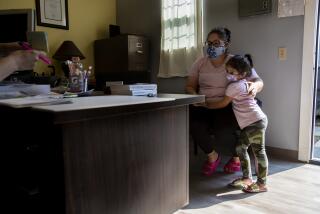Editorial: California needs to do more than apologize to people it sterilized
- Share via
As part of the vile eugenics movement that swept the country during the first half of the 20th century, more than 60,000 women and men were sterilized in state homes and hospitals to prevent them from passing on what were considered defective genes.
Laws in 32 states allowed sterilizations to be performed at state-run institutions on people deemed “feeble minded” or mentally ill or even, in some cases, sexually promiscuous. However, nowhere was eugenics more aggressively practiced than in California. About 20,000 people in California were sterilized, mostly between 1920 and 1960, although the state law was in effect from 1909 to 1979. Most were forced or coerced. All were in the care of the state at the time. In some cases, hospitals made sterilization a condition for discharge. This newspaper’s publisher for much of the first half of the 20th century was a supporter of eugenics, and a regular column ran in the paper extolling its virtues.
Former Gov. Gray Davis issued a public apology for the practice in 2003. Apologies were issued in six other states as well. But is that enough? A recent paper published in the American Journal of Public Health by a University of Michigan professor, Alexandra Minna Stern, estimates that as many as 831 survivors of the procedure are alive today in California. While the law did not single out people by race or income, people who were poor and those with Spanish surnames were disproportionately sterilized. Stern believes the state government of California should offer reparations.
Reparations seem like the last chance to make a strong statement.
There’s no question that what was then considered a public health program is now recognized as a deplorable human rights abuse that robbed people of their reproductive rights. But does it require reparations? People of Japanese descent who were forced into internment camps during World War II received compensatory payments many years later. Although much debated, there has never been a program of reparations for slavery, the ultimate American human rights abuse.
The real question, according to both Stern and Georgia State University College of Law Professor Paul Lombardo, should not be which evils are worse than other evils. A better question is what is feasible and fair. In this case, there are reliable records of who was victimized — and the possibility that many are still alive and could be traced.
Furthermore, a judicial solution seems unlikely. A class-action lawsuit would probably not succeed, scholars say, because these sterilizations were done under the auspices of duly passed state laws — which were upheld as constitutional by the U.S. Supreme Court decades ago. So reparations seem like the last chance to make a strong statement.
It could be a challenging task for the state to locate people who were sterilized — and are now probably in their late 80s — and persuade them to confirm or discuss what happened to them. Barely a handful of people in California have come forward in the last decade on their own to speak about their victimization. But why not try?
Two states — North Carolina and Virginia — have already offered monetary reparations to victims of coerced sterilization. North Carolina offered $50,000 per survivor while Virginia offered $25,000. (By contrast, Japanese Americans who were interned were given $20,000 each by the federal government.)
If there are indeed 831 survivors, and each were to receive, say, $25,000, that would cost the state approximately $20 million — which wouldn’t bust the state’s budget and doesn’t seem like an unreasonable price for taking away someone’s ability to have children.
State officials should quickly begin tracking down these elderly victims who were abused decades ago while under the state’s care. Time is short to do right by them.
Follow the Opinion section on Twitter @latimesopinion and Facebook
More to Read
A cure for the common opinion
Get thought-provoking perspectives with our weekly newsletter.
You may occasionally receive promotional content from the Los Angeles Times.








